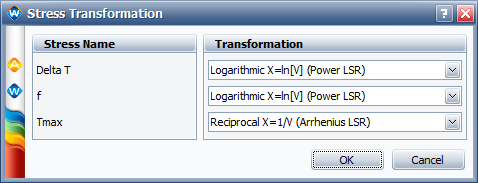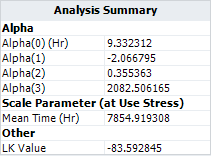Norris-Landzberg-Exponential Model: Difference between revisions
Jump to navigation
Jump to search
No edit summary |
No edit summary |
||
| Line 1: | Line 1: | ||
{{Reference Example|ALTA_Reference_Examples_Banner.png|ALTA_Reference_Examples}} | {{Reference Example|ALTA_Reference_Examples_Banner.png|ALTA_Reference_Examples}} | ||
This example compares the results for the Norris-Landzberg relationship | This example compares the results for the Norris-Landzberg life-stress relationship. This can be accomplished in ALTA by using the general log-linear model (GLL) with proper stress transformations. | ||
| Line 10: | Line 10: | ||
{{Reference_Example_Heading2}} | {{Reference_Example_Heading2}} | ||
The following table shows the thermal cycling profiles and test results for chip-scale package solder joints. In this example, the thermal cycling profile is represented by three independent stresses. These are: maximum temperature (<math>\,\!T_{Max}</math>), temperature difference (<math>\,\!\Delta T</math>) and cycling frequency (<math>\,\!f</math>). | |||
The thermal cycling profiles and test results for chip-scale package solder joints are given below. A thermal cycling profile can be represented by 3 independent stresses in Norris-Landzberg relationship. They are the maximum temperature (<math>\,\!T_{Max}</math>), the temperature difference (<math>\,\!\Delta T</math>) and cycling frequency (<math>\,\!f</math>). | The thermal cycling profiles and test results for chip-scale package solder joints are given below. A thermal cycling profile can be represented by 3 independent stresses in Norris-Landzberg relationship. They are the maximum temperature (<math>\,\!T_{Max}</math>), the temperature difference (<math>\,\!\Delta T</math>) and cycling frequency (<math>\,\!f</math>). | ||
Revision as of 15:13, 13 June 2014
ALTA_Reference_Examples_Banner.png

